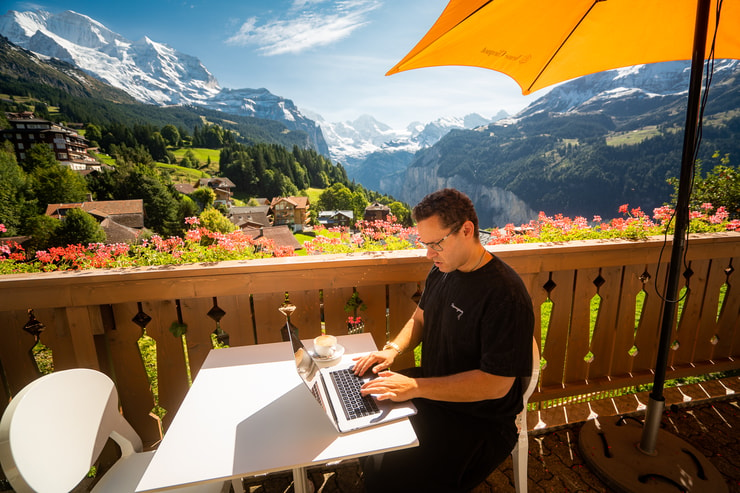Have you ever seen an amazing setup, but refused to take it because you were on a losing streak?
You didn’t want another loss to put you in a deeper hole.
And while that might sound responsible or even logical….
It’s the WRONG way to trade.
Losses happen all the time. It’s part of trading.
Focusing on your P&L won’t make you a better trader.
Instead, I want you to focus on everything that happens BEFORE you hit the bid.
These are the top elements every trader needs to work on if they want to improve their trading in the long run.
Table of Contents
Focus on Your Decisions

2025 Millionaire Media, LLCCan you control where a stock goes once you enter a trade?
Neither can I.
And there’s no crystal ball that will tell you the answer either.
Trading is an exercise in risk management and probabilities.
All we can do is stack the odds in our favor as much as possible and adjust our risk accordingly.
It’s like playing Texas Hold’em.
You can start with pocket Aces, but there’s no guarantee you’ll win by the end.
Heck, sometimes you can lose with the best hand multiple times in a row.
However, if you make the right decisions over and over, eventually, the odds will work in your favor.
So, what do I mean by focusing on the right decisions?
That comes down to four key areas:
- Chart patterns
- Setups
- Entry signals
- Execution
Chart Patterns
I focus largely on penny stocks making parabolic moves.
In fact, I’ve got it down to a science known as my 7-Step Penny Stock Framework.
The framework tells me where a stock is in its parabolic lifecycle.
After all, I know most of these companies eventually go under.
Since I know that what goes up must come down, I match my setups to the parts of the 7-Step Lifecycle.
More Breaking News
- BULL Anticipates Strong FY Earnings Amid Strategic Moves
- Why is BitMine Immersion Rising?
- TeraWulf Stock Surges Amid Strategic Collaborative Shift
Once I have the pattern, I then move on to the setup.
Setups
The setups I use aren’t complex
Typically they fall into three categories:
- First Red/Green Day
- Panic Dip Buys
- Breakouts
The trick is knowing when to look for the setup based on the pattern.
For example. Let’s say I’m watching a hot stock like Canopy Growth (NASDAQ: CGC).
As it makes its initial run, I’d look for breakout trades and panic dip buys.
On the back side, I’d only look for panic dip buys.
This is why I’m a big fan of panic dip buys. They tend to work anywhere in the Supernova pattern.
Between the setup and entry signals is also where I determine my size.
I choose my risk based on how volatile the stock is, the price of the stock, and the overall market.
For example. If a stock is up 100%, I put $1,000 on the trade risking 5%. But if a stock is up 50%, I would need to increase my size if I lower my risk to 2.5%.
As a rule of thumb, your position size should be based on loss management. Figure out how much you’re willing to lose on each trade and calculate your share size based on that number given your potential entry and stop loss (which we’ll talk about next).
Entry Signals
Once I know where I’m at in the pattern and which setups apply, I then look for my entry signal.
Here’s an example of a morning panic dip buy in WeWork (NYSE: WE).
Shares doubled the day before and held pretty close to their highs.
All I wanted to see was a morning panic dip into support, which is exactly what happened.
This wasn’t anything fancy. Just a well-thought-out plan.
I saw the pattern and chose the appropriate setup.
Then, I waited for my entry signal, watching the support level and the price action.
Execution
The last step, which is where most traders focus their attention, is on the execution.
However, this should be pretty straightforward if you’ve done all the pre-planning.
With WE, all I had to do was execute my buy order once I saw shares dip and bounce back a little.
From there, I kept a tight leash on the trade, not wanting to let it drop much further because my number one rule is to cut losses quickly.
Fortunately, I rode this trade for some juicy profits.
Crafting the Perfect Plan…For You

2025 Millionaire Media, LLCCreating a trading plan isn’t hard. Yet, most traders struggle because they don’t know where to start or what to include.
But more importantly, they try to create a trading plan they think I want to see.
Every trader is different.
I don’t expect you to trade exactly like me.
My goal is to make you the best trader YOU can be.
That’s why my upcoming LIVE Strategy Session is designed to teach you how to take these fundamental steps that happen before you enter a trade and tailor them to YOU.










Leave a reply